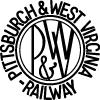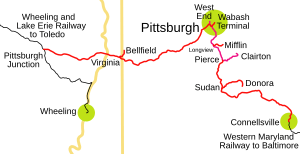Pittsburgh and West Virginia Railway facts for kids
 |
|

The P&WV formed a connection between the Wheeling and Lake Erie Railway and Western Maryland Railway.
|
|
| Overview | |
|---|---|
| Headquarters | Greentree, PA |
| Reporting mark | PWV |
| Locale | Connellsville, Pennsylvania to Pittsburgh Junction, Ohio |
| Dates of operation | July 2, 1904–October 16, 1964 |
| Technical | |
| Track gauge | 4 ft 8 1⁄2 in (1,435 mm) standard gauge |
The Pittsburgh and West Virginia Railway (PWV) was a special kind of railroad in the areas of Pittsburgh, Pennsylvania, and Wheeling, West Virginia. It was first built as the Wabash Pittsburgh Terminal Railway. This railway was meant to be an extension of George J. Gould's Wabash Railroad into Pittsburgh.
However, the company faced money problems in 1908. The railway then became independent. In 1931, a new section was added. This connected the railway to the Western Maryland Railway at Connellsville, Pennsylvania. This connection became part of the "Alphabet Route". This route was a group of independent railway lines. They linked the Northeastern United States with the Midwest.
In 1964, the Norfolk and Western Railway leased the Pittsburgh and West Virginia Railway. This was part of a bigger plan to take over parts of the Alphabet Route. Later, in 1990, the P&WV was leased to a new company called the Wheeling and Lake Erie Railway. This happened just before the Norfolk and Western merged into the Norfolk Southern Railway.
The original Wabash Pittsburgh Terminal Railway built some huge structures. One was the Wabash Terminal in downtown Pittsburgh. This building was damaged by fires in 1946 and taken down in 1953. The Wabash Bridge crossed the Monongahela River into Pittsburgh. It was removed in 1948. On December 27, 2004, the Wabash Tunnel, which was near the bridge, opened as a special road for cars with many passengers. This tunnel goes through Mount Washington. Even today, the two supports of the old Wabash Bridge are still standing.
The railway also had a few smaller lines. One went to West End, Pennsylvania, but it was closed in 2011. Another was called the Mifflin Branch, which went to West Mifflin, Pennsylvania. There was also a small industrial line near Belle Vernon, Pennsylvania.
Contents
The Railway's Story
Building a Big Railway Network: 1901 to 1908
Around 1900, a man named George J. Gould wanted to create a huge railway system. His goal was to have a railway that stretched all the way across the country. He already had railways that went from the Pacific Ocean in San Francisco to the Mississippi River in St. Louis. These included the Western Pacific Railway, Denver and Rio Grande Railroad, and Missouri Pacific Railroad. From St. Louis, Gould owned the Wabash Railroad, which went to Toledo.
In 1901, Gould and his partners decided to extend this system to Pittsburgh. They bought a railway company that had permission to build into downtown Pittsburgh. Soon after, they also took control of the Wheeling and Lake Erie Railroad. This railway went from Toledo to Zanesville, Ohio, and Wheeling, West Virginia.
Building the extension to Pittsburgh involved three different companies. Work on this new line began in June 1901. It branched off the Wheeling and Lake Erie line at Pittsburgh Junction, Ohio. In May 1904, these three companies joined together to form the Wabash Pittsburgh Terminal Railway. The first train went through the Wabash Tunnel and crossed the Wabash Bridge on June 1, 1904. Passenger service into the new Wabash Terminal started on July 2, 1904. This allowed people to travel to Toledo, Chicago, St. Louis, and Kansas City.
Gould had even bigger plans. He wanted to connect his railway system all the way to Baltimore. However, not all parts of his plan were finished. The Panic of 1907, a financial crisis, hit Gould hard. Building these railways was very expensive. Because of this, some of his railway companies, including the Wabash Pittsburgh Terminal Railway, faced serious financial trouble in 1908. This stopped the direct train service between Pittsburgh and the other railway systems.
Becoming Independent: 1908 to 1929
After several years of being managed by others, the company was finally sold in 1916. It was then reorganized and renamed the Pittsburgh and West Virginia Railway. People started to think about this railway as part of a "Fifth System". This new system would be a major player alongside the four biggest railways at the time. However, there was still a missing link. The P&WV and the Wheeling and Lake Erie needed to connect to the Western Maryland Railway.
The existing West Side Belt Railroad helped with this connection. It crossed the P&WV line and went southeast towards Clairton. In December 1928, the government approved the P&WV's plan to take over the West Side Belt.
Changes and New Connections: 1929 to 1964
In 1929, the Pennsylvania Railroad created a company called Pennroad Corporation. This allowed them to invest in other transportation companies. They bought a large part of the P&WV.
On February 11, 1931, the new extension to Connellsville, Pennsylvania, finally opened. Here, the Western Maryland Railway continued east. This completed what became known as the Alphabet Route. This route was similar to George Gould's original idea. It used the Nickel Plate Road to reach St. Louis and Chicago. The P&WV and Western Maryland did not connect directly in Connellsville. They used a short section of another railway's track to link up.
In 1949, the Nickel Plate railway leased the Wheeling and Lake Erie. Then, in 1950, there were plans for the Nickel Plate to lease the P&WV as well. In 1962, the Norfolk & Western Railway wanted to include the P&WV in their upcoming merger with the Nickel Plate. On October 16, 1964, the Norfolk and Western bought the Nickel Plate and leased the P&WV. The Western Maryland Railway, however, ended up joining other railway companies later on.
After the Western Maryland Railway's main line closed in 1975, a new connection was made. The P&WV connected to the Baltimore and Ohio Railroad near Connellsville. This helped keep a version of the old Alphabet Route going.
Under Norfolk and Western: 1964 to 1990
The Pittsburgh and West Virginia Railroad was set up in 1967. Its job was to own the railway property that was leased to the Norfolk and Western Railway. This company is now part of Power REIT, which is a company that owns real estate.
The leased properties include a railway line that is 112 miles long. It goes through several counties in Pennsylvania, West Virginia, and Ohio. There are also smaller branch lines that are about 20 miles long. The railway was leased in 1964 for 99 years. The lease can be renewed for another 99 years. The Norfolk and Western Railway, now Norfolk Southern, is responsible for keeping the railway in good condition. They also manage and operate it. Any improvements they make become the property of the Pittsburgh & West Virginia Railroad.
The Pittsburgh & West Virginia Railroad's main business is to own these properties and collect rent from the lease. If the lease ever ends, all the properties would be returned to the Pittsburgh & West Virginia Railroad. They would also get enough money to operate the railway for one year.
Wheeling and Lake Erie: 1990 to Today
On May 17, 1990, Norfolk Southern created a new company called the Wheeling and Lake Erie Railway. They transferred most of the old Wheeling and Lake Erie lines to this new company. The lease for the P&WV was also given to the new Wheeling and Lake Erie. This new company also gained the right to use tracks belonging to CSX Transportation from Connellsville east to Hagerstown, Maryland.

